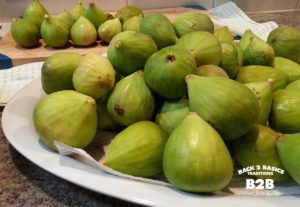Why let an abundance of delicious in-season foods go to waste during times of plenty when there are many simple ways to conserve them?
Here at Back 2 Basics Traditions we are fascinated with the many different methods of food preservation. From sun drying, to smoking, to curing, pickling, and making jams. Yes, those brilliantly colourful jars of sweet jam is a traditional method for conserving in-season fruits.
The conserving of fruits has quite an interesting history which reveals how explorers and trade routes influenced culinary traditions throughout the world. Steeped in tradition and availability, the Mediterranean cultures typically preserved foods using olive oil, vinegar and distilled liquids, while the Romans had an affinity to use honey to preserve fruits and flowers. It is believed that jams were first introduced into Europe with Crusaders returning from the middle east where sugar cane cultivation was widely established. As trade routes with the middle east opened, sugar started to influence culinary traditions with jam recipes detailed in one of the earliest cookbooks, called “Of Culinary Matters”, which dates back to 1st century Rome. From Europe, the Spanish Conquistadors took the process of making Jam to the Caribbean where fruit was in abundance.

There are a many different forms of Jam depending on how the fruit is processed. Look at any supermarket shelf and you will see Jam products under the different titles like Jelly, Jam, Preserve, Conserve and Marmalade. Do you know the difference? Here is a list of what makes each type of Jam different:
· Jam – Made with chopped, crushed or puréed fruit that has been cooked down with sugar.
· Jelly: Made with only the juice of the fruit and sugar. It contains no seeds, whole or chunks of fruit.
· Preserve: Contains chopped or whole fruit that has been cooked with sugar until a thick syrup liquid that is able to suspend the fruit develops.
· Conserve: Is a preserve that has been made with more than a single fruit. It often includes raisins and nuts.
· Fruit Spread: is a modern jam product made with sugar alternatives like fruit juice concentrates. When sugar prices soared in the early 1970s, high fructose corn syrup (HFCS) became a popular substitute.
· Fruit Butter: Is made with fruit that has been pureed and cooked down with sugar, lemon juices and spices to a smooth, spreadable consistency.
· Marmalade: Traditionally a citrus based jelly made with bitter citrus peel.
If you enjoy eating jam you are in ‘high’ company! Marmalade was a favourite in Royalty once Catherine de’ Medici (from the culinary fond Medici family) married King Henry II and the physician to Mary, Queen of Scots used Marmalade as a treatment for the Queen’s seasickness. It is also said that Joan of Arc would always eat quince jam before a battle as it gave her courage.
It might not give you courage but Fig Jam is one of our timeless favourites! Figs are tasty fresh and make a great addition to desserts, especially when complemented with Vino Cotto or honey. But they are also make delicious Jam!!
Fig Jam is also easy to make… you will curse the lack of courage to not having made it earlier!
How You Can Make Fig Jam Fit For Royalty
Ingredients
- 1kg fresh figs
- 1/2 cup freshly squeezed lemon juice
- 3/4kg white sugar (or 1/2kg sugar and 1/2 cup of honey)
- 1/4-1/2 cup of Vino Cotto
Instructions
1. Prepare figs by trimming off hard stem-end and slicing each fig into quarters.

2. Place sliced figs into a food processor and blend slightly so it is still chunky.

3. Put figs into a saucepan with the lemon juice. Bring slowly to a simmer and keep simmering for 15 minutes until figs are soft. With a wooden spoon, break up any large pieces.
4. In a separate saucepan, warm sugar and then add to the figs and stir over low heat until sugar has dissolved.
5. Increase heat and boil uncovered for approximately 25-30 minutes.

6. Add in Vino Cotto (and honey if using) and stir in well.

7. Continue to boil for another 5-10 minutes or until jam jells when spread on a cold saucer.
8. Pour jam into sterilised jars and cap.
9. Place a large tea-towel into a pot so that the tea-towel drapes over the sides.
10. Place jars in pot and fill with boiling water from kettle to just below jar rim. Cover the jars with the overhanging tea-towel.
11. Bring water to boil and boil for 10 minutes. Remove from heat and leave to cool in pot.

What type of Jam do you like to make?
Make sure to let everyone know in the comments below.
Please remember to sign up to our ‘Be A Cook, Not A Chef’ newsletter to receive our latest recipes, tours and cooking experience details, product updates and member only specials. Simply use the sign-up form below the comments section.
Informative Links
- Museu de la Confitura: History of Jam – http://museuconfitura.com/en/historia-de-la-confitura/
- Pure Jam: History of Jam – http://www.purejam.com/History_of_Jam.htm
- Project Gutenberg’s Cooking and Dining in Imperial Rome – http://www.gutenberg.org/files/29728/29728-h/29728-h.htm
- Fruit Preserves – https://en.wikipedia.org/wiki/Fruit_preserves









I made this jam it is delicious.